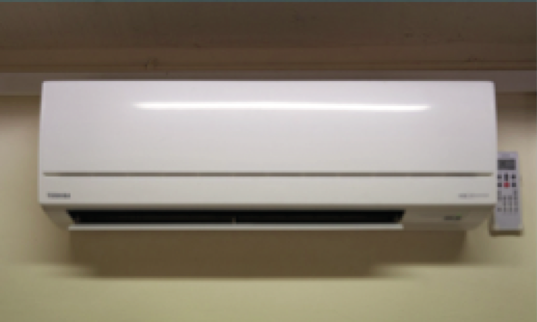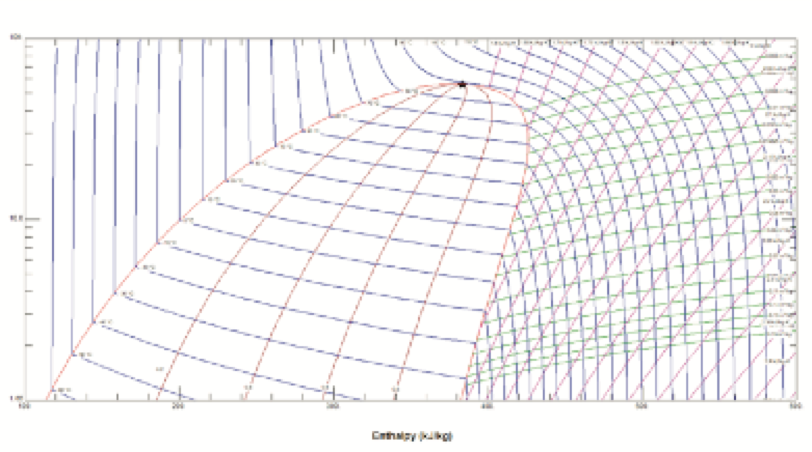RS-53 (R470A)
New non-flammable low GWP Drop-in replacement for R410A. The ONLY retrofit alternative to R410A on the market with A1 safety classification
RS-53 (R470A) is a new non-flammable Drop-in replacement for R410A with a low Global Warming Potential (GWP) less than half that of R410A. RS-53 (R470A) has a similar thermodynamic performance to R410A with matching energy efficiency and cooling capacity. RS-53 (R470A) is compatible with the materials commonly found in R410A equipment. In particular, RS-53 (R470A) contains low toxicity components already known to have excellent chemical stability in air-conditioning units.
RS-53 (R470A) is an exciting new development in the quest to replace higher GWP refrigerants in both existing and new equipment. RS-53 (R470A) enables users to replace R410A in existing units with minimal changes and inconvenience at low cost. RS-53 (R470A) is compatible with lubricants typically used with R410A avoiding the need to change the existing lubricant when retrofitting. RS-53 (R470A) is thus an excellent option to replace R410A, not only in the European Union where F Gas regulations are creating shortages, but also in other countries which are introducing restrictions on the sale and use of refrigerants containing hydrofluorocarbons.
R32 is being introduced as a replacement for R410A in new equipment, but is not suitable for use in existing equipment because it is flammable. In contrast, RS-53 (R470A) is a retrofit solution being non-flammable, low toxicity and with similar cooling capacity, pressures and Coefficient of Performance to R410A.




Performance Characteristics
- Low direct GWP Drop-in replacement for R410A
- Similar energy efficiency to R410A
- Close match for R410A in cooling capacity
- Similar discharge pressure to R410A
- No changes to hardware required during retrofitting
- Compatible with lubricants commonly used with R410A
- Replaces R410A in air conditioning and refrigeration applications
- Similar flow rate to R410A
- Zero Ozone Depletion Potential
- Non-flammable & low toxicity
GWP quota system in the European Union
The F-Gas Regulation, or “Regulation of the European Parliament and of the Council on fluorinated gases and repealing Regulation (EC) No 842/2006” is an EU legislative instrument which is directly applicable in all EU Member States. The phase-down is a step-by-step approach where the quantities of HFCs expressed in CO2 equivalent that are placed on the market are gradually reduced through the allocation of quotas by the European Commission to producers and importers of bulk HFCs. As a result of the phase-down, HFC consumption will be reduced by 79% by 2030. This is an unprecedented reduction and means that industry and users need to make the transition to refrigerants with a lower global warming potential.
The baseline year for HFC consumption has been set as 2015 under this regulation and cutbacks in quotas related to 2015 have already taken place, firstly a 7% reduction in 2016 which was raised to 37% in 2018. A further cutback to 55% of the baseline year will take effect in January 2021. Not surprisingly shortage and high prices have been the result which have led to extensive quantities of illegal imports, thereby threatening the phase down of HFCs in the EU.
The introduction of RS-53 (R470A) aims to help alleviate the shortfall between what is available under F Gas and demand in the market by in effect enabling over 2 tonnes of RS-53 (R470A) to be made available to users for every 1 tonne of R410A. Crucially, RS-53 (R470A) is non-flammable and therefore can be used in place of R410A in existing equipment and installations, which of course is not possible in the case of R32 which is flammable and so only suitable for use in new equipment where regulations permit.
The planned cutbacks in 2021 and continued thereafter until a ceiling of 21% of the baseline year is permitted in 2030 will significantly accentuate the shortage of refrigerants and/or force users to purchase new equipment in the absence of innovations on the supply side. RS-53 (R470A) should help to alleviate this problem with its much lower GWP compared to R410A. RS-53 (R470A) has been specifically designed to mitigate these changes to the refrigerant user by reducing the direct GWP of the refrigerant while not compromising its energy efficiency and technical properties as a suitable Drop-in replacement for R410A.
Applications
RS-53 (R470A) has been developed to replace R410A in existing installations, although it can also be used in new equipment. The problem has been to find a refrigerant which is non-flammable but also with similar properties so that it can easily replace R410A in practice and at low cost. In the European Union one of the direct effects of the F Gas regulations has been to restrict the availability of R410A. But now the availability of lower GWP RS-53 (R470A) enables users to avoid the cost of purchasing new equipment, since it significantly increases the refrigerant volume, available under F Gas, for servicing existing systems. RS-53 (R470A) has similar cooling capacity, energy efficiency, discharge pressure, discharge temperature and mass flow as R410A and consequently an excellent choice to replace R410A.
Applications for RS-53 (R470A) include but are not restricted to commercial and residential air conditioning, splits, commercial & industrial refrigeration, transport refrigeration, chillers, heat pumps and others.
Because the mass flow of RS-53 (R470A) is similar to R410A, RS-53 (R470A) can be used in systems both with a capillary, fixed orifice or variable expansion devices.
Lubricants
RS-53 (R470A) is suitable for use with the same lubricants that are found in R410A systems, avoiding the need to change the oil when retrofitting to RS-53 (R470A).
Safety
RS-53 (R470A) is non-flammable as per ASHRAE Standard 34 based on annex of ASTM A681. The components of RS-53 (R470A) have been subjected to toxicity tests carried out by the Alternative Fluorocarbons Environmental Acceptability Study (AFEAS), and have been declared to be of low toxicity.
Servicing
Because RS-53 (R470A) is a blend, it should be charged into the system in the liquid as opposed to vapour form. There is no need to make any hardware changes when converting from R410A to RS-53 (R470A) which can be used with expansion devices having a fixed orifice or adjustable setting.

Physical Properties
| Property | RS-53 (2) | R410A (2) | |
|---|---|---|---|
| Molecular Mass | 84.43 | 72.6 | |
| Boiling point (1 atm) (1) | °C | -62.7 | -51.4 |
| °F | -80.8 | -60.5 | |
| Critical Temperature | °C | 88.7 | 71.3 |
| °F | 191.7 | 160.4 | |
| Critical Pressure | bara | 55.91 | 49.00 |
| psia | 810.8 | 710.6 | |
| Liquid Density (25°C) (1) | kg/m3 | 1101 | 1059 |
| Density of saturated vapour (25°C) (1) | kg/m3 | 61.47 | 64.87 |
| Latent Heat of Vaporisation at boiling point (3) | kJ/kg | 268.5 | 273.0 |
| Heat capacity constant volume Cv (25°C & 1bara) | kJ/kg.K | 0.749 | 0.700 |
| Heat capacity constant pressure Cp (25°C & 1bara) | kJ/kg.K | 0.854 | 0.823 |
| Cp/Cv (25°C & 1 bara) | 1.141 | 1.1755 | |
| Vapour Pressure (25°C) (1) | bara | 18.43 | 16.57 |
| psia | 267.3 | 240.4 | |
| Vapour Viscosity (25°C & 1 bara) | cP | 0.0130 | 0.0133 |
| Liquid Viscosity (25°C) (1) | cP | 0.139 | 0.118 |
| Liquid Thermal Conductivity (25°C) | W/m.K | 0.0846 | 0.0892 |
| Surface Tension (25°C) (1) | N/m | 0.00623 | 0.00521 |
| Specific heat of liquid (25°C) (1) | kJ/kg.K | 1.58 | 1.71 |
| Ozone Depletion Potential | ODP | 0 | 0 |
| Global Warming Potential AR5 | GWP | 909 | 1924 |
| Flammability limit in air (1 atm) | vol% | none | none |
| Inhalation exposure (8 hour day & 40 hour week) | ppm | 1000 | 1000 |
(1) Bubble point
(2) RS-53 refrigerant properties obtained from NIST's REFPROP v10 program.
(3) Difference between bubble point liquid enthalpy and dew point vapour enthalpy at 1 atm.